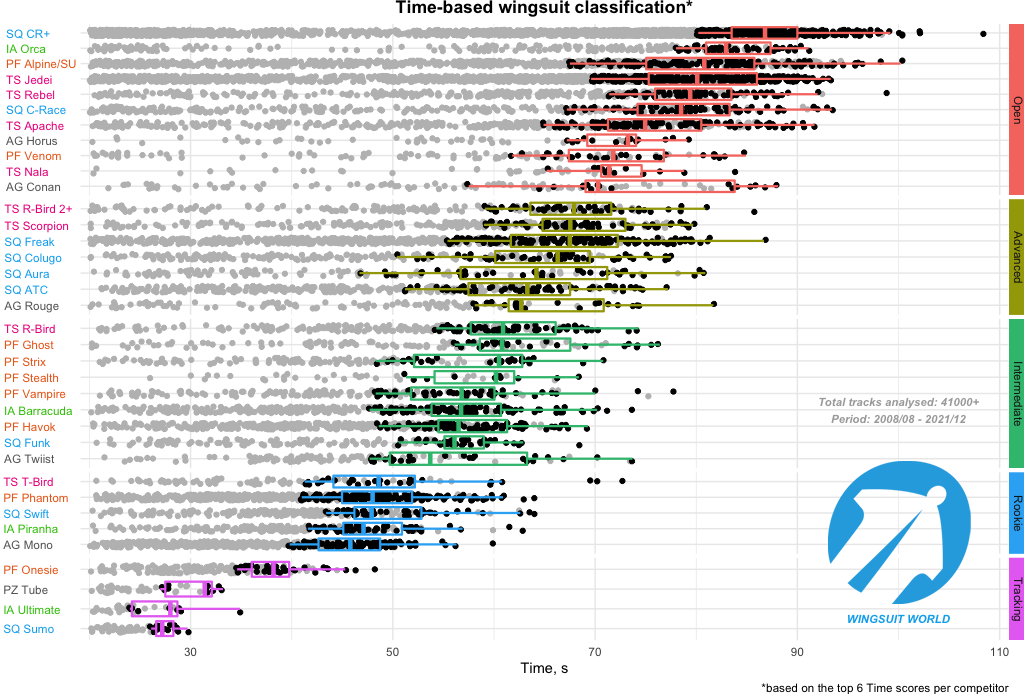
(click here for the Time results table)
Analysis of all publicly available tracks from three main websites (Paralog, Skyderby, and Wingsuit World) was performed in order to help competitors and competition organizers better separate wingsuit performance classes. Only scores for the Time task were analysed in this study. Extensive name identification and track selection was performed to eliminate erroneous and duplicated entries (e.g., identical competition tracks uploaded to multiple platforms) and generally ensure clean data.
Track selection procedure:
- All pilots with fewer than 6 tracks to their name, and all suit models with tracks from fewer than 3 different pilots were eliminated from the dataset to minimize the number of unrepresentative entries.
- Up to 6 best Time results from each pilot were considered (for every suit model separately). For pilots with low number of tracks (from 6 to ~30) a smaller number of (representative) tracks was retained (~best out of every 6 posted results, up to a maximum of 6).
- Results from the 1st quantile (lower 25%) for each suit model were discarded, to eliminate outliers with atypically low scores.
- For tracks prior to 2020, the 3000-2000m competition window was used. For track starting January 2020, we used the new 2500-1500m competition window instead.
As a result, a total of just over 2500 tracks from 700 different pilots were selected for the final analysis. Note that this study does not aim to determine best achievable results for each wingsuit model. Instead, it is more reflective of the best results of each wingsuit, given the average pilot skill level for this model (performance skill levels of people flying Intermediate and Open class suits are typically different).
A few notes:
- PF Alpine/SU includes all tracks from PF Vampire Alpine, Alpine 2, Vampire Competition, Sukhoi, etc.
- TS Jedei includes models Jedei 1, Jedei 2, Jedei 3, J3N, J-Nite, Jedei 2019, etc.
- TS Apache includes models Mach, X-Bird, X3, etc.
- TS R-Bird 2+ includes models Foghead, R-Bird 2, R-Bird Pro, R-Bird 3, etc.
- IA Barracuda includes models Barracuda Freestyle, Barracuda Power, Barracuda 2
- PF Vampire includes typically old models like Vampire-2, Vampire-3, Vampire-4 and Vampire-5, and excludes Vampire Alpine/Sukhoi
- PF Strix, PF Hunter, IA Shark: insufficient data to make a conclusive classification decision between Advanced/Intermediate classes. Our subjective assumption is that Distance/Speed results, as well as more Time results from other competitors, will show higher scores achieved by these models than the ones currently available.
The above classification should serve as a guidance only. It is always a job of event organizers to separate competitors into performance classes that make most sense in each particular case. Further refinements of the proposed here classification scheme will be attempted (e.g., including wind-cancelled Speed and Distance results). Your feedback on this topic is welcome (feel free to contact us). The goal of this study was to illustrate the following two important points:
- Wingsuit classification schemes based on the length of arm and tail wings are extremely inadequate for estimating performance levels of wingsuits and must be abandoned. They do not take into account any of the important factors determining performance for PPC competitions, such as internal wing structure, outdated wingsuit designs, pressurization, intended use (BASE/acro/racing), and many others.
- At the same time, there exists no perfect wingsuit classification scheme, and the one presented here has its own drawbacks. The best we, as a community, can do is to come up with a way to make wingsuit performance competitions most interesting for the majority of competitors, and in particular for Intermediate and Advanced pilots. In particular, pilots flying Advanced (non-race-specific wingsuits), even those with large projected surface area, should not be forced to compete against pilots flying race suits from the Open class.